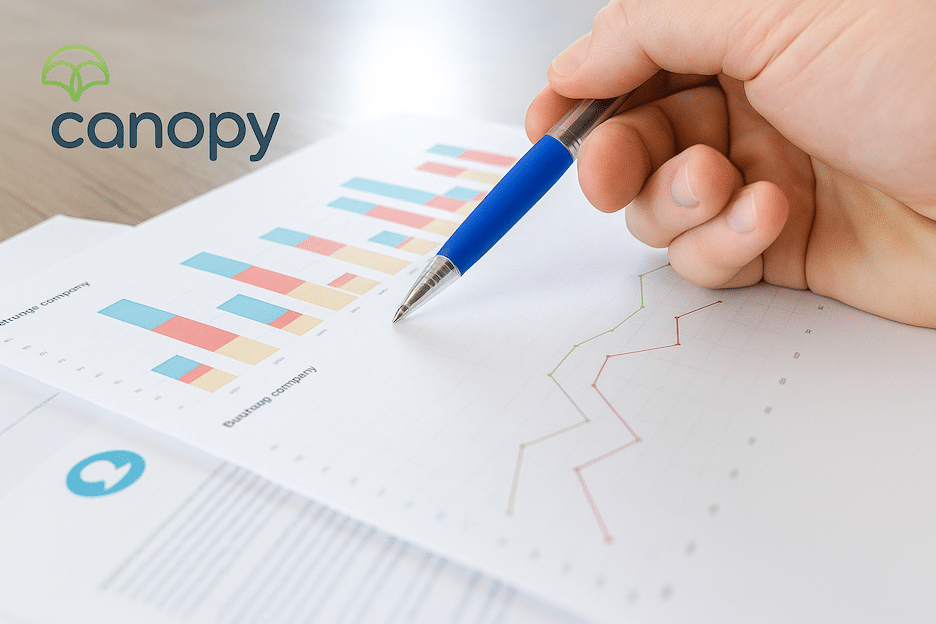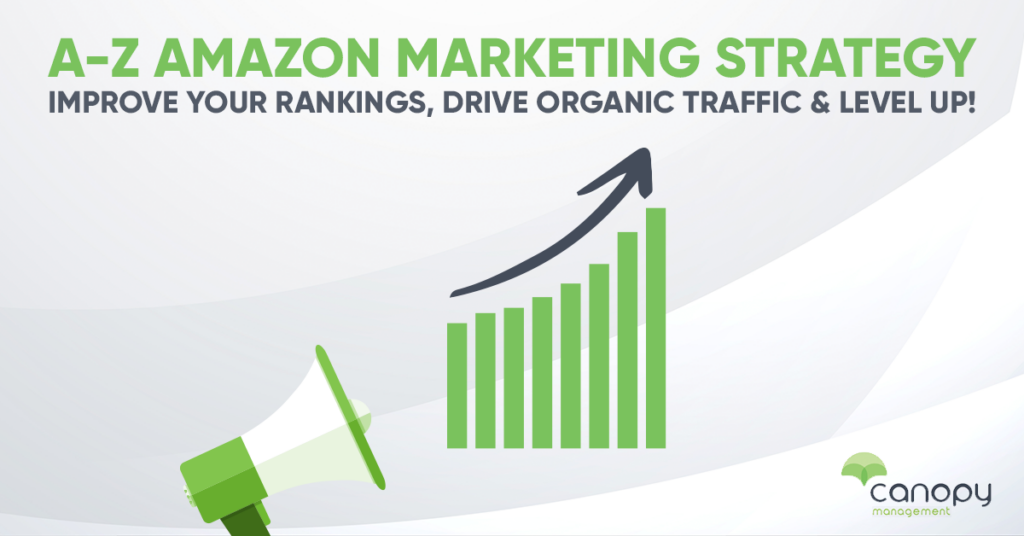5 Reasons NOT to Ignore Your Amazon Seller Metrics
The 5 Amazon Metrics That Make or Break Seller Success – Are You Tracking Them? Missing These Could Cost You Everything You’ve Built

Understanding Amazon’s seller metrics has evolved into a sophisticated data science in 2025. As Amazon’s algorithm continues to prioritize external traffic, seller authority, and AI-powered performance indicators, monitoring the right metrics has become more crucial than ever for marketplace success.
At Canopy Management, we’ve helped partners achieve an average 84% profit increase by strategically analyzing and optimizing the metrics that matter most in today’s algorithm-driven marketplace. Our ecommerce experts leverage AI-powered analytics tools and real-time data mining to identify the most impactful metrics for sustainable business growth.
If you neglect your Amazon seller metrics in 2025, you’re not just risking poor performance – you’re risking algorithmic invisibility in an increasingly competitive landscape where over 67% of shoppers browse on mobile devices and voice search accounts for 10.8% of digital buyers.
This post will explain five critical risks you face when ignoring important Amazon seller metrics, plus how to leverage AI and modern analytics tools to stay ahead of the competition.

Amazon Seller Metrics You Need to Prioritize in 2025
To run a profitable Amazon business in 2025, understanding and monitoring your seller metrics requires a strategic hierarchy. Not all metrics carry equal weight in Amazon’s current algorithm, and successful sellers focus their attention on what drives real algorithmic and financial impact.
While Amazon’s search algorithm is still technically called A9, many industry experts believe that given its substantial evolution and AI enhancements over the years, it would be more accurate to refer to it as an Amazon A10 algorithm, reflecting the significant changes in how it processes and ranks products.
For the purposes of this post, we’ll continue to refer to Amazon’s algorithm as A9.
Understanding the Metrics Hierarchy
Before diving into the critical risks of ignoring key metrics, it’s important to understand how successful sellers prioritize their attention across different metric categories:
Tier 1: Critical Metrics for 2025 Success
- Return on Ad Spend (ROAS)
- External Traffic Conversion Rate
- Seller Authority Score
- Mobile Conversion Rate
Tier 2: Important Supporting Metrics
- Organic Sales Velocity
- Voice Search Performance
- Brand Share Analysis
- AI-Optimized Inventory Turnover
Metrics to De-Prioritize
- Best Seller Rank (BSR) – Too volatile for strategic decision-making
- Click-Through Rate in Isolation – Misleading without context
- Lowest Price Strategies – Ignores long-term profitability
The Cost of Neglecting These Metrics
In the fast-moving Amazon ecommerce world, knowing your seller metrics is crucial. It can be as important as the products you sell. Operating without knowing these metrics is like navigating without a compass. It will take much longer to reach your destination, and all that extra time is costing you money.
As an Amazon brand management agency, our job is to make sure that our partners know that we have eyes on these metrics so they don’t have to. Instead, our partners can take a step back, and make more broad, long range decisions with their brand.
But, not everyone has the luxury of a Full Service Amazon Management. That’s why it’s important for Amazon sellers to pay close attention to these numbers.
With that in mind, let’s examine the five critical business areas where ignoring these essential metrics can damage your Amazon business in 2025:

1. Poor Inventory Management Triggers AI-Powered Algorithmic Penalties
Poor inventory management in 2025 goes beyond storage costs – it now directly impacts your algorithmic standing. Amazon’s AI systems continuously evaluate seller reliability, and inconsistent stock levels signal unreliability to the platform’s ranking algorithms.
Modern inventory management requires AI-driven demand forecasting that analyzes multiple data sources: historical sales patterns, PPC spend correlation, seasonal trends, and even external market indicators. Tools like SoStocked now use machine learning to predict demand with 90%+ accuracy, preventing both costly overstocking and ranking-damaging stockouts.
The 2025 Inventory Challenge:
- Long-term storage fees have increased significantly
- Amazon’s algorithm penalizes frequent stockouts more severely
- Multi-channel inventory synchronization across Amazon, Shopify, Walmart, and TikTok Shop is essential
- AI-powered reorder points prevent both overstock and stockout scenarios
When you neglect modern inventory metrics and management, you risk triggering Amazon’s reliability algorithms that can suppress your listings even when you restock. Smart sellers now use automated systems that sync inventory across all channels and trigger restocking based on AI-powered velocity predictions rather than manual monitoring.
The bottom line: Manual inventory management puts you at a severe disadvantage against competitors using AI-powered forecasting and automation tools.

2. Missing External Traffic Opportunities That Boost Organic Rankings
In 2025, the biggest growth opportunities exist outside Amazon’s platform. The updated Amazon algorithm now prioritizes products that successfully drive external traffic from Google SEO, social media marketing, and influencer partnerships. Sellers who ignore external traffic metrics miss the algorithm’s most powerful ranking factor.
Critical External Traffic Metrics to Monitor:
- Google search rankings for product-related keywords
- Social media engagement rates and click-through to Amazon
- Influencer partnership conversion rates
- Off-Amazon advertising ROAS
Smart sellers now track their Google rankings for product keywords as closely as their Amazon rankings, because Google traffic that converts on Amazon receives massive algorithmic boosts. A product that ranks on page one of Google for its primary keyword and successfully converts that traffic on Amazon can dominate its category.
The External Traffic Advantage: When you drive qualified traffic from external sources that convert well on Amazon, the algorithm interprets this as market validation. Your organic rankings improve across the board, creating a compounding effect where external marketing efforts boost internal Amazon performance.
Ready to Start Growing Your Amazon Brand?
Canopy’s Partners Achieve an Average 84% Profit Increase!
Find out more3. Algorithmic Reputation Damage That Compounds Over Time
Seller reputation metrics in 2025 carry more algorithmic weight than ever before. Amazon’s AI systems now track reputation trends and predict future performance, meaning small reputation issues can compound into major visibility problems through algorithmic learning.
Key Reputation Metrics Amplified by AI:
- Order Defect Rate (ODR) – must stay below 1%
- Feedback trends and sentiment analysis
- Response time to customer inquiries
- Return rate patterns and reasons
Modern AI tools can help maintain reputation by automatically generating professional responses to customer complaints and questions, ensuring consistent communication quality. Sellers who manually manage customer service often fall behind in response times and quality, triggering algorithmic penalties.
The Compounding Effect: Amazon’s AI doesn’t just look at current metrics – it analyzes trends and predicts future performance. A seller with declining feedback scores receives algorithmic treatment as if future problems are inevitable, creating a downward spiral that’s difficult to reverse.
4. Mobile and Voice Search Invisibility in a Mobile-First Marketplace
Ignoring mobile optimization metrics in 2025 means missing (at least) 67.2% of your potential audience. Amazon’s algorithm now separately evaluates mobile performance, and poor mobile conversion rates can suppress your listings even if desktop performance is strong.
Critical Mobile Metrics:
- Mobile conversion rate vs. desktop
- Mobile page load speed and engagement
- Voice search keyword performance
- Mobile image visibility and appeal
Voice search optimization requires tracking completely different keyword patterns. Voice shoppers use conversational, question-based queries that traditional keyword research misses. Products optimized for “best running shoes” might miss voice searches for “what are the most comfortable running shoes for marathon training?”
The Mobile-First Reality: Sellers who optimize primarily for desktop Amazon browsing are effectively invisible to the majority of modern shoppers. Mobile optimization isn’t just about responsive design – it requires understanding mobile browsing behavior, shorter attention spans, and voice search patterns.

5. Reduced Profitability Through Inefficient AI Utilization
The biggest profitability risk in 2025 is competing against sellers who effectively leverage AI while you manage everything manually. AI-powered competitors can optimize pricing, advertising, and inventory faster than human analysis allows, creating sustained competitive advantages.
AI Advantages Your Competitors May Have:
- Real-time dynamic pricing based on competitor analysis
- Automated PPC bid optimization that responds to performance changes instantly
- Predictive inventory management that prevents stockouts and overstock
- AI-generated listing optimization that improves conversion rates
Manual management of complex Amazon operations now creates significant disadvantages. While you’re analyzing yesterday’s data to make today’s decisions, AI-powered competitors are making real-time optimizations based on live market conditions.
The Profitability Gap: Sellers using AI tools for analytics, inventory management, and advertising optimization consistently achieve higher ROAS and better profit margins. The efficiency gap between AI-assisted and manual management continues to widen as AI tools become more sophisticated.

Implementing a 2025 Metrics Strategy
Week 1-2: AI Tool Setup
- Implement AI-powered analytics platforms for real-time monitoring
- Set up automated alerts for critical metric thresholds
- Establish baseline measurements for all Tier 1 metrics
Week 3-4: External Traffic Integration
- Launch Google SEO campaigns for product keywords
- Begin social media traffic driving initiatives
- Implement tracking for external traffic conversion rates
Month 2: Mobile and Voice Optimization
- Audit all listings for mobile performance
- Optimize for voice search keyword patterns
- Implement mobile-specific conversion tracking
Month 3+: Continuous AI-Powered Optimization
- Analyze performance data using AI tools for pattern recognition
- Iterate strategies based on algorithmic response
- Scale successful tactics across your entire catalog
Frequently Asked Questions
Q: What’s the most important metric change for Amazon sellers in 2025? A: External traffic conversion rate has become the most impactful metric. Amazon’s algorithm now heavily rewards products that successfully convert traffic from Google, social media, and other external sources.
Q: How has mobile optimization affected Amazon metrics? A: With upwards of 67.2% of Amazon visits now coming from mobile devices, Amazon evaluates mobile performance separately. Poor mobile conversion rates can suppress listings even if desktop performance is strong.
Q: Should I still track Best Seller Rank in 2025? A: BSR is too volatile for strategic decision-making in 2025. Focus instead on brand share analysis within specific keywords and external traffic performance.
Q: How do AI tools change Amazon metrics management? A: AI tools enable real-time optimization that manual management can’t match. Competitors using AI for pricing, advertising, and inventory often achieve 20-30% better performance metrics.
Q: What’s the biggest metrics mistake sellers make in 2025? A: Ignoring external traffic opportunities. Many sellers focus only on internal Amazon metrics while missing the algorithm’s strongest ranking factor: successfully converting external traffic.
Partner with Canopy Management for AI-Powered Metrics Excellence
Managing Amazon seller metrics effectively in 2025 requires sophisticated tools, AI integration, and deep understanding of algorithmic priorities that go far beyond basic seller knowledge. The platform’s evolution toward external traffic prioritization, mobile-first indexing, and AI-powered decision-making demands specialized expertise.
That’s why successful brands partner with Canopy Management. Our team of former Amazonians, multi-million dollar sellers, and award-winning experts leverage cutting-edge AI tools and real-time analytics to optimize the metrics that matter most in 2025’s marketplace.
When you work with Canopy Management, you gain access to:
- AI-powered metrics analysis and automated optimization
- External traffic strategies that boost organic Amazon rankings
- Mobile and voice search optimization expertise
- Real-time inventory management using predictive analytics
- Advanced reputation management and customer service automation
- Cross-platform metrics integration for Amazon, Walmart, and TikTok Shop
Our partners achieve an average 84% profit increase because we focus on the metrics that drive real algorithmic and financial impact, not vanity numbers that don’t affect your bottom line.
Ready to leverage AI-powered metrics management for sustainable Amazon growth? Contact our experts today to discuss your 2025 optimization strategy.
Canopy Management is a full-service marketing agency for Amazon, Walmart, and TikTok sellers. Our team consists of multi-million dollar, omni-channel entrepreneurs, industry leaders, and award-winning experts.
When you consider the many ways that Canopy Management can help you grow your business, you’ll see why selling on Amazon is much easier “under the Canopy.”
Thinking About Hiring an Amazon Management Agency?
Canopy’s Partners Achieve an Average 84% Profit Increase!
Let’s talk


